The Swiss ML Testakica
This machine exists today in a commune near Bern Switzerland and could have the answers to our energy needs.
The Unit is started by hand by revolving the two disks in opposite directions and continues to move without further input. This device has only two moving parts namely the bearing races at the centre of the disk.
The disk are made of acyclic plastic upon which are placed flat a series of fifty blade type steel or aluminium sections equally spaced around the middle sections of each disk.
The speed of the revolving disks is about 50 to 60 rpm limited to this by magnetic impulses from the magnetic section on the rim.
To those that have seen this powerhouse in operation it is certain that useable power is being extracted from the environment and some is being used to run the machine.
This is an energy system which relies on the self moving wimhurst electro static generator for the high voltage and somehow the members of this commune have found a way to extract, amplify and convert this energy to powerful useful levels.
The Swiss M/l converter is based on a modified wimhurst electrostatic machine.
My people have seen the swiss m/l converter in operation but to do date no one has been able to understand or successfully reproduced the results as claim by the Swiss commune group Methernith in Linden.
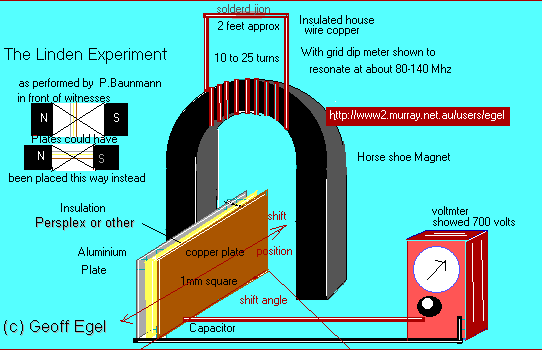
But to one fortunate individual had a visit to Paul B.who is claimed to have had said that if they could understand the above following experiment they would be close to understanding how the device was able to work.(as illustrated above)
It consists of two plates of metal one aluminium the other copper separated by a insulator of some unknown material could be paper or plastic(unknown)
It also included a horse shoe magnet wrapped with a coil of wire and both ends soldered together.
Paul B placed this capacitor made of the differing metals between the poles of a horse shoe magnet and then asked a witnesses to connect the plates to two probes of a voltmeter to each plate and to their surprise found a voltage of seven hundred volts which occasionally dropped in value.
I have communicated with some people how have performed the above experiment with little result however.
WHAT I THINK HAPPENED ALTHOUGH I DON'T KNOW FOR SURE
PB may have conditioned the insulator of perspex of other similiar insulator by the following means without revealing what he had had done.
It is known that if you heat perspex until soft to touch and becomes tacky and you then subject the heated mass to a high voltage field via means of metal plates on each side of perspex mass and leave it there until the perspex is cool.
Removing the applied high voltage charge (The electret effect) an electrostatic high voltage charge may still be continously taken from those metal plates, something like this also happens with the electrostatic microphones in modern tape recorders.
What part the magnet and the coil and differing face metal plates plays in additional to the electrostatic charge is yet to be determined by yours truly.
Looking at other parts of the machine the pickup fields that don't touch the spinning disks are also made up of perforated Aluminium separated with a perspex insulated and with copper behind it.
I would like to know if any one has performed the above experiment and got a successful result.
Base of the Wim Hurst machine
The theory of operation of a wimhurst machine is. The disks are of plastic, glass, hard rubber or in one case I saw old phonograph records."The contra-rotating disks causes air molecules to become electrically harged by the frictional movement of the air across both disks."
"Note: The contra-rotation of the disks actually perform a function which is best defined as 'charge differentiation', in that one disk becomes charged negative, with an excess of electrons. Whereas the other disk becomes charged positive, or has an electron lack - in accordance with modern terminology and the thinking of solid-state physics. This is not an excess of protons! Merely the stripping off of electrons, creating a positive charge on the disk."
To stop this flash over, a series of foil sections are attached to the centre portion of each disk and equally spaced and back to back with foil sections on the outer sides.
To remove the charge, collection arms are arranged to collect the charge and transfers the charge to a storage capacitor. At 45 degrees to these collection points is a neutralising bar that extends to full length of the disk and has brushes at both ends.
A neutralising brush equals the charges on the metal foil position at both positions on both sides.
The neutralising bar on opposite side disk is at ninety degrees to the one for the other side.
Whats in the big can
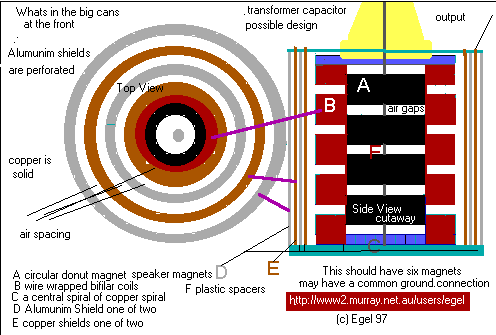
For many the cans in front of the Testakica have proved to be a bit of a mystery.
From information I have obtained the general opinion is that the above diagram is close to explaining what in the twin cans. It seems to a combination of two copper cylinders interlaid with two perforated alumina screens
In the middle are six or more doughnut magnets upon which are wrapped coils some think they could be bifilar in nature.
Between each magnet there is an air gap made possible by the plastic spacers between each of them.
In the middle of the magnets there is a single spiral of copper or aluminium metal.
It is possible although not confirmed that there is a common ground at the bottom of each can connecting all these elements.
Don't quote me on this but it reminds me of an automotive transformed connected in reverse and shielded with copper and aluminium shielding.
I not sure what roles the magnets provide but tesla used a magnet field in his designs to give a dc voltage output like modern day rectifiers in some of his AC circuits.
The magnets may also work similiar to work carried out by Captain Hans Coler.
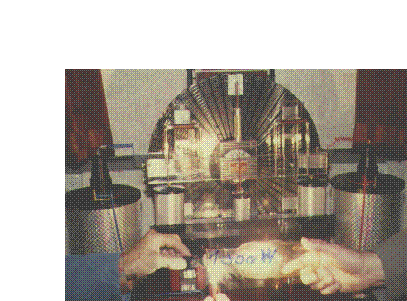
Some facts know about this machine. Constant Power output 230 volts at 13 amperes for a 3kw rating pulsed DC
Dimensions 110cm wide 45 cm deep 60cm high
43.23 wide 17.68 deep weight approximately 20kg/ or 44 lbs X23.58
Self propulsion by way of the esf flow principle of motorised brushes to revolve the twin disks.
The machine is started by hand revolving the disk after this no additional input power is required.
Once unit is functioning it is not able to be moved with the machine coming to a stop.
The temperature in the area of the machine tends to become cooler.
P.B. seems to be in the area next to or by the machine when first started.
Additional Information
There also seem to be a four inch single disk version that gave out 300 watts but I know only little of this at the moment.
Although not always seen a small motor is used to turn both disks at a constant speed in opposite directions in both devices.
I have a 25 minute video of the Swiss ML in operation in the Australian Pal format.
I am continually searching for addition information about this device and if there is anyone who has additional information on it's construction and operation I would be most grateful as I have already built a wimhurst machine ,I would now like to construct a ML machine.
If you have any information on this device and you send it to me it will be kept confidential if you so wish.
Letters
Some I have recieved as of (28/Sept/97) unconfirmed.
The correspondent has written to me:
I currently think the energy comes from a different dimension, and that a toroidal-type oscillating magnetic field can be a catalyst for n energy transfer. (This is a loose and poor description)"
In the middle of the magnet stacks in the large containers could be a "wire". Now, this is what Don Kelly from S.E.A. tells me. an electrode like the one Prof. Stefan Marinov described in the small machine. In a post card Prof. S. M. Said, "The capacitors have a cylindrical grid, cylindrical plastic insulator and a copper spiral in the center. I saw in one of the small machines there are NO MAGNETS."
About the permanent magnets, The chief technician (Luzi Cathomen) told a freind of mine (The Linden Report 1994)that the ends of the magnets or in the cass of the magnet stacks between the magnets seems to work the best. The toriod coil could just be used for energy storage but I don't know.
If you or some one else could get the Linden Experiment (according to U.P.Sander)to work then the Testatika could be explained. Insted of a two foot loop try hooking your Wim. static generator up to the Wires around the hours shoe magnet then try placing the flat Cu. Al. capacitor between the poles. may be d/c power would come out insted of the static electricity going in.
Report supplied by Albert Hauser
Report: Methernitha Linden, Switzerland.
Together with my two companions, I visited the community Methernitha in Linden, on the 14th February 1986.
During our 4 hour long visit, we did following observations.
First, my shorted report was printed in our association newspaper "DIFOT-News" no. 5, May 1986, later in UFO-Contact no. 6, 1986 and last the English version from the same publisher, February 1987. The persons in Linden asked me to be patient in publishing our observations via the big magazines.
During the ongoing time I have had the possibility to compare my ideas with the other visitors. Further we have seen rather good pictures, and reports from other visitors. These have been printed in bigger news letters allready.
Even relatively many persons have seen the tecnology already, until now the shown technic isn't understanded. To avoid misunderstandings, bad reputations and also to avoid the possiblities for misuse of the system, I have decided to give my opinion, this concerning.
Based on the quistions to our hosts we received following respons:
They described themself as primitive Christians. - A community counting approx. 200 persons, living "biblical" together, with their own school, machine factory, market-garden and also a film studio.
That's the reason why they did'nt want to publish the developed technic, which has taken approx. 25 years to develop. - Especially because they were afraid of the ossibility of misuse, - also from the weapon-industry.
It's maybe wellknown, that the device has to be hand-started and thereafter the machine is self-running.
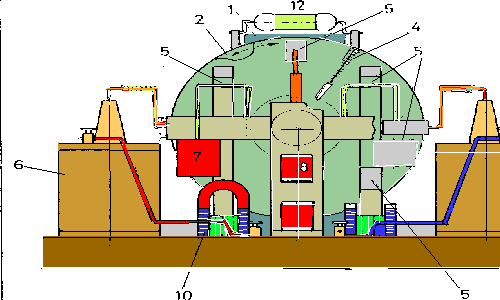
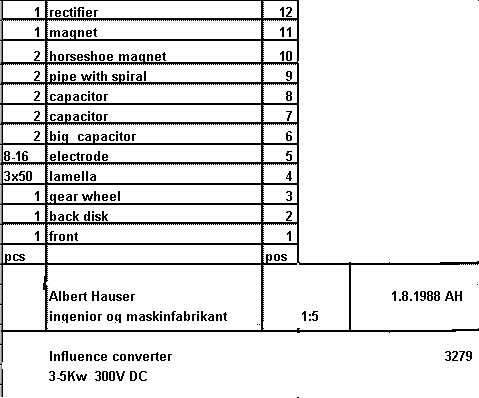
The performance is partly known, and corresponding data is stated on my drawing.
During our visit, the big machine was tested with a 1.000 watt glow-lamp. (there was also a smaller machine) The machine(s) was mainly constructed of traditional parts and materials.
The shown machine weighed approx. 20kg. - The foundation plate was of wood and the rest was mostly made of plexiglas.
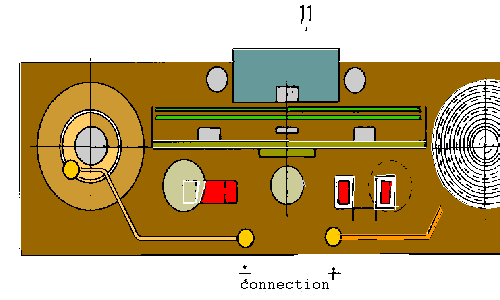
pos. 1 Plexiglas disk ø 500 × 5 mm with 50 chrome-steel lamellas, approximately 0,2 × 20 × 160 mm, placed on the outside surface. - This was called "the cloud"
pos. 2 Correspondingly big disk of the same material, but in a darker colour, but running in the opposite direction, and with lamellas placed on both the sides. - This was called "the ground"
pos. 3 Magnet wheel against a timing gear for braking the disks pos. no. 1 and 2. (Controling the speed at 60 rpm) The disks was connected with a flexible belt transmission.
pos. 4 The lamellas was a little magnitized and made of a material/or coated for protection against corona oxidation.
pos. 5 All lamellas are made of perforated sheets of metal and all without touching the disks. There is 8 pcs on the front of the disks and maybe also 8 pcs on the back side. The last mentioned is'nt placed parellel with the disks. - The electrodes is turned edging in a radius, and by turns assembled in lays of perforated plates and isolating plates.
pos. 6 Concentric acryl pipes between 3 perforated sheeded pipes (metal-coating and in the center a bifilar coil around a magnet-tupe.
pos. 7 and pos. 8. - A smaller lying "capacitor"
pos. 9 A glass-tupe around an aluminium spiral, which really was a revolving shaving.
pos. 10 Horse shoe magnets with coils which are turned bifilar, and between the shoe-legs several lays of isolating sheets and perforated metal sheets.
pos. 12 Possibly a rectifier. - An oblong piece of perforated metal plate placed vertically and around a coil. The glass cover contains one or several crystals.
In accordance with the notes from other visitors, the end-caps are magnetic.
In my opinion, the systen isn't evacuated, because a smaller machine had a quite open rectifier.
The electric connections between the single parts can only be mentioned uncompletely. But the likeness with the old "Wimhurst machine" is clear. Here we have several electrodes. (Wimhurst have totally 6, and 4 of them are touching).
The horizontically placed electrodes are - like "Wimhurst" transmitting the high voltage itself to pos. 6.
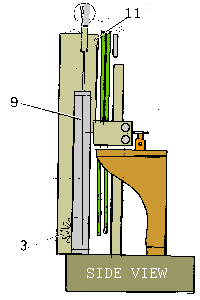
There is a question concerning the center magnet or the coatings. - The many coatings are internally connected, - also to pos. 7 and 8, and partly also to other parts, like pos. 9, 10 and 12.
The useable performance, shown on'the drawings with the + and - connections, and on the coloured photos with read and blue wirings, looks like as if they where connected from 2 metal rings placed on the top of pos. 6.
In accordance with the reports from other visitors, the thick wooden foundation plate should be made in turns of lays of perforated plates and isolating plates.
Also they started a smaller machine which was running in 2 hours. We tested the machine with only measuring instruments. It means to say, that we didn't load the machine with any resistance. I think the performance is maybe 200 watt.
Surprising, but this model was'nt so heavy, only approx. 1 kg. The size of the disk was only approx. 12 cm, and the construction was much more simple. (few "capacitors" only)
The self running mechanism was constructed of a little traditional DC-motor, which for the use was winded with thinner thread.
Re: Testika (Swiss ML) Machine
A similar device was to have been demonstrated at the EXOTIC RESEARCH conference. This conference ran for four days. July 23 to July 26 1998.
Calvin B. from International High Tech. is now in the process of building this device. We are able to build this as recent information has been obtained from The Boston Musium of Science. At the end of the conference we will tell ALL!
I have no additional informational at this stage about this device.
Correspondence received March 1998
I have received this letter from a contact some parts identify people has been deleted.
March 10 99.
an extract follows.
Now to the ML converters in general. When I talked to two the two engineers Sauder and Snicker who had made measurements on earlier models. I mentioned those variations and fantastic assumptions made by other researchers.
Then S and S looked at me and started to smile. They said that the constructions done by those who tried to copy the machines in one or other manner are "on the wrong track". Taking a photograph (or a video and making a Japanese copy is the wrong way to do it.!
Sheer guesswork is not the way to get a result!
The principle must be understood!! Sauder sad that the converters they had tested were extremely simple! eg the big jars or capacitive "pots" (of earlier models) were plastic containers filled aluminium shavings like those you get when you turn a rod of material on a lathe.
Also there was not a so called rectifier diode on top; it was a kind of solenoid with a movable jumper ,like that of a potentiometer or variable inductor. Baumann had to tune that jumper after S & S had partially disassembled and inspected one of the machines.
It is a pity that engineers although competent in their proper disciplines do not observe precisely and memorise what they have been working on! This also with S and S, not an exception.
Nevertheless I can trust (not believe) what Sauder tells me.
Here an argument why Methernitha was certainly not showing a Hoax.
When we look at recent developments and estimate the material costs we must say it is very unlike that such tremendous efforts are made to impress outsiders with hoax machines.
The elephant still does not work. It seems to me that the Methernitha have gone now through the phase of mystic physics.
At present they have to get back the money they have spent for the new factory and the setting up of the electronics production; This only comes by hard and realistic work.
It may be a configuration I have thought of when I came back to Linden in September 1994.
Here we again see coils, permanent magnets, a capacitor .When we consider where the Testakica power comes from in the first place. then it are those "pots" on the sides! Whatever the excitation of these combinations might be, the secret lays in the pots. Paul Baumann had his reasons why he uses high voltage excitation. It is how he started and never abandoned this scheme. When you look at the elephant with its 2 meter disks and what is mechanically involved - it is a real mess and over killing. The elephant might even never run as expected.
Here I should say, again that I trust much more the technique with magnets than with wimshurst disks. My friend Werner Kunz recently got a strong stoke from a 20000 volt charged capacitor. He told me he could hear the angels signing.
With magnetic circuits there is less danger and magnets can hold much more energy than capacitors. The Volkrodt circuits seam the right path to follow. The explanations given in his 1985 paper sound logical, although I have not gone though the calculation and formulas.
I am mainly an experimenter. What I can prove by measurement I can trust! I am definitely facts oriented. All other beliefs are out of my consideration.
End of extract
Latest information as of June 2000
From: Stefan Hartmann
Subject: Re: Reverse engineering Testatika, electret function!
The following is a email message regarding the testakica that may shed some light on its actual construction.
Question
By the way what do you think is in the two large cans.
I think it may be some type of step down transformer something akin to a automobile spark coil instead of in reverse high voltage to low voltage.
Yes, it might be transformers from HV down to lower voltage, but maybe also just nothing only Leyden jars ?
I noticed on the video the voltage on voltmeter was somewhere about 200-300 volts if I can remember correctly and I didn't see anywhere else they had mounted a step down voltage device.
Answer
It could be just a capacitive transformer.
Example
Load a 1 µF cap with 1000 Volts, now discharge it to a 100 µF cap and you will have at this cap a voltage of about 10 Volts or so but now with big current output!
Capacitive transformer effect!
Look at the drawing of Mr. Holzherr.
The plexiglas arm with its mesh electrodes is nothing else than a simple electret formed via plexiglas and 2 mesh electrodes.
One aluminium mesh electrode and at the other side steel mesh electrode!
Electrets are also done this way. One HV charged dielectric with one electrodes on each side!
The electret arm has a static HV charge which it INFLUENCES (electrically induces) into the block of brass meshes and plexiglas under it, when the plexiglas arm is swept back and forth by Mr. Baumann!
This way he is able to charge the 2 capacitors up.
Now the whole Testatika machine consists of 2 electret discs rotating in counter direction. This is also why the 2 discs or at least one disc MUST HAVE ON BOTH SIDES mesh electrodes! It must be an electret disc having the metal electrodes on each side of the plexiglas disc! Via the metal mesh electrodes the electric charges are got out from the non conducting plexiglas disc!
This is just done via INFLUENCE into the "taster" electrodes as Methernitha calls them. (collecting pick up electrodes) Now imagine the 2 electret discs acting like permanent magnets in the electrical field! They just attract each other, until the mesh electrodes align with PLUS and Minus to each other. This was also reported by Stefan Marinow, that the discs tended to rotate from alone, if you stopped them.
So this tells us, that the 2 discs want to align this way, that the electrodes want to have the opposite polarity so to attract each other and influencing inside each other and inside the brushless pick up electrodes big voltages via influence, which are charging up the Leyden jars.
Now, if they have aligned after maybe 10 degrees of rotation, then there comes an electric impulse via the switching of the HV motor (coils with permanent magnet rotor) going to the pickup "taster" electrodes and reverses the polarity in at least a few segments of at least one electret disc, so there is an imbalance and the electret discs can rotate on and the next segments attract each other.
I guess, inside the smaller 300 Watts models we just only have one electret disc rotating and fixed electrets (crystal type electrodes with meshes fixed to them, so there the rotation speed is much higher, cause "one disc" is fixed and the "other" disc is rotating!
Now, why is Mr. Baumann using wire mesh instead of full foil electrodes. It seems he uses the polarized ions of the air as the power source, so to trap as many as possible ions he probably needs the wire mesh, so also the ions have contact to the surface of the plexiglas electret polarisation surface. This way normal air is ionised and is trapped between the discs and the charges of the ionized air are separated and pushed onto the meshed metal electrodes and thus produce more electricity.
This is it, what he calls: "One disc is the earth and the other disc is the cloud and it produces electricity due to nature secret of lightning."
He just collects as much as possible separated ion and electron charges from the air and to separate them he needs the contact with the plexiglas, that is why he uses the mesh electrodes! Cleverly done!
Did you know one cm3 of air has about 1023 molecules which could be charge separated, when I remember correctly?!
That is also why the bigger you build the discs the more electrical power you get! This is also why the 30 KW machine needs 2 meter diameter sized discs.
BTW, the HV is CAPACITIVELY transformed down to about 270 to 300 Volts.
It seems to be a capacitive transformer via different sized Leyden jars and switching the charges between them can transform the high voltage down, if you go from small capacitance HV Leyden jars to bigger capacitance Leyden jars, the voltage is automatically transformed down!
This is probably down also via this HV motor and its commutator and also via this diode, which is mentioned, which is probably so I guess the Testatika machines are not any more this mysterious. It is just an electrostatic influence machine done via electret discs.
Also imagine the experiment from Graham Gunderson done with an HV electret as the power source and not a charged oil capacitor! This will also charge up the Avramenko plug very good!
(The Avramenko plug in its simplest form, if I understand correctly is made up two diodes and a capacitor, each end of the capacitor has diode connected to each side and the other side of each un connected diode side is exposed to an electrostatic field and left to charge.
I guess we now need to find good materials for electrets to build! Think about it.
Hope this clears up some mystery also for you!
Regards, Stefan.
An interesting observation I made when playing around with my wimshurst machine, was both discs did not need to move at the same relative speed as long as there was some motion of the disk moving in opposite directions. That is one disk could be rotating faster that the other disk but they had to be in opposite directions.
Has anyone else noticed this effect as well?
Here are some Infos from Mike Watson which Marinov told him
Date: Sat Jul 21, 2001 4:51 pm
Subject: Marinov on the Testatika etc
Hello All,
Some years ago I met Stefan Marinov in London and took the opportunity to question him about the Testatika. As is well known Marinov was a member of the "inner circle" of I think twelve members who ran the Methernitha group in Linden. Marinov was the only one not in on the secret of how the testatika worked. However, Baumann unexpectedly gave Marinov one of the small machines to play with.
Marinov said that the two Leyden jars contained no magnets. The central electrode was a helix of a few turns of thick wire. The concentric mesh were simple cylinders insulated from each other by clear plastic cylinders.
The machine had a single revolving disk with iron wire for sectors. The wire was threaded from one side to the other radially on the disk face as can be clearly seen in the photos of the small machines.
The machine would only start with the disk axis pointing east-west. When operating, if the disk was stopped with the finger there was a steady torque on the disk. If a sheet of metal was held behind the machine the rotation stopped and the rest torque stopped.
There are no rubber contacts or brushes on the disk. A few spins with the fingers would start the machine. The wheel of the machine delivered less than 100mw according to Marinov's estimates. Marinov had an electrostatic motor, and said that the torque on the testatika disk at rest was greater than from his electrostatic motor. The testatika disk revolved 30-40 times slower than that of the electrostatic motor.
During his tests he estimated that the power output was about 100 watts as judged by the heating effect in a power resistor.. Marinov had no test equipment available to do quantitative tests since all these observations were made at Linden, and Marinov did not expect to be shown anything when he visited.
These early machines were built by Baumann when in prison from scrap materials found in the workshop. Baumann also said that the sectors of the big machine were a lightly magnetised special Fe-Ni alloy.
Unfortunately Marinov is no longer with us, he told me that the group would tell him the secret provided his swore an oath of not disclosure. He would not do this because he regarded this as against the spirit of science.
The Methernita group seem to think that the Testatika is based on principles not known to current orthodox science.
What about unorthodox science? It seems to me there is plenty here for fruitful research. The problem is that dowsers and others do detect such unorthodox EM-like fields but no satisfactory instrumentation exists to detect them objectively. Objective instruments do exist but are of an unsatisfactory statistical nature. Quantisation and energy conservation go hand in hand. If an unquantised Electromagnetism exists and given the apparent uselessness of conventional instruments for such fields a new method of detection would be needed.
If Baumann is using such unorthodox fields in the Testatika then presumably he discovered the field first and created the machine after to prove it to himself.
Regarding such fields, what about the Bedini scalar field generator, orgone, Karl Welz's chi generator, Dowsing fields etc. All these point hazily to another unknown power.
Mike Watson.
email message from: testatika@yahoogroups.com newsgroup
This was translated from a home video made at Mathernitha.
Documentation of the Testa Distatika of amateur video film .
Present persons:
1 man of Methernitha (M) and 2 Germans (D) and (T), hardly talks.
M: There is not yet quite finished, there come still segments drauf. I can show these segments here you. Belong still drauf. Only then it begins to function.
D: Is that magnets?
M: No those are special alloys.
D: Is that magnet foils?
M: One could magnetize those.
D: A magnetized foil is that now and those drauf is stuck here.
M: See that are a 2-metriger and a that are a meter. And 4 KW deliver there. That is those, which saw to Dr. Winter. Those delivers 4 KW.
D: Those delivers 4 KW?
M: Half of the double converter.
D: Is that a double converter?
M: That is exactly the same again.
D: Why do you build those not parallel, but now more largely in the diameter?
M: We are to, we are to.
D: I mean to build parallel am that for advantage or more largely to be built. What is the advantage?
M: I would estimate stationary, which delivers it approximately 20kW.
D: 20kW?
M: Yes. And there should approximately half of there.
D: Thus approximately 2kW?
M: Yes. There did I see still one (machine there above) in tandem it?
D: I see her there in front.
M: That is in tandem. May I tell briefly or do interest it you not? Can they make smaller or not?
D: Make how smaller?
M: Yes, if they have 4.
D: Well, theoretically one could switch 6 or 8 consecutively.
M: Yes, gehts more simply if they knew each disk 2 KW of gittern. They can make that. But is for a newspaper?
D: No, it really interests me.
M: Approximately 60, not faster.
D: 60 revolutions for the 50 cycles per second.
M: Those are the Kondenser.
D: Those are leydnische bottles?
M: (those are the leydnischen bottles, thereby one the voltage get there ago). And from there we take the current away.
D: I.e. as said, the principle functions in such a way, which one the electrostatic field...
M: jawohl.
D: one forms das.
M: That is, like if it straehnen exactly here has, that it ahead already saw.
D: Is clear, is clear. With what is the energy removed now?
M: The energy is removed then there.
D: To both Poland.
M: and go..... Those are still special (is).
D: Moment,the energy goes now from here where to?
M: That can be done there up.
D: Here above drauf?
M: and there it is strengthened.
D: What is called strengthened to that extent?
M: That is called simple..... There do we quote one.... as say one?
D: Transformer.
M: Transformer.
D: It is converted?
M: No, it is up-changed. We do not need that. We have direct current.
D: Here however is high voltage of like much 20?
M: No, those are 100, 100, 100kW.
D: 100kV
M: Yes. That gives such a flame.
D: And goes here above drauf. And that is..... which is still times exactly?
M: That is thing, with what we increase the capacity or?
D: Moment as is increased now here the capacity? As that is made.Spark gaps or which is that.
M: No, there are only magnets and things (coils?) in it. Where we there there....
D: That you do not want thus to say which it are.
M: No I would also not like that.
D: Well. Thus like said thus it goes here.
T: Important!
D: Property of OK ONE. That can be done say here drauf and strengthened it. And then the energy continues?
M: The energy comes then down on the condensers and it is stored there.
D: On the wrong niches bottles?
M: Yes, on the wrong niches bottles. And from there evenly it leaves.
D: For what still times here in front was this section?
M: The section.
D:Yes. M: that is........(lachen)
D: Well. A type is spark gaps.
M: Jas that is it, but I cannot do it you.....
D: Is a vacuum inside.
M: Vacuum, I means......
D: Vacuous. Vacuum is which other one.
M: Vakuu
Best Regards, Ken
Some email comment from Dipl. Ing. Stefan Hartmann
Now it is also clear to me, how the Testatika works. Baumann has also found out, that he could extract much more energy, when the pulsed HV pulses onto radioactive minerals and rocks. As he is a mineral collector, he probably tried, how a high voltage pulse could enhance the output of such small radioactive rock or mineral!
As in the big capacitors is said they contain a single vortex wire inside some rock material it is now clear, that this is probably the collector wire for the electrons, which are produced during the High Voltage excitation!
Also the basic experiment from Baumann, with his swing arm modell machine and the charging of the capacitor could be this principle!
A high power electret in the upper arm is fast moved a few times over the stack of weak radioactive mineral sandwiched between collector mesh electrodes and this way this mineral gets a few High Voltage induction pulses, thus it is stimulated to release many high speed electrons, which charge up the mesh collectors and thus the capacitor! This probably is also true for the horseshoe-magnets, which have these mineral plates with metal collector electrodes stacked up! These minerals must be weakly radioactive and if the magnet field is modulated or the electrodes a fed with High voltage pulses, they will release beta electrons and charge up the electrodes around them.
I also once heard, that inside the background tubes there are many stones and minerals inside there, this is probably also a container for weak radioactive stones and rocks which are pulses in this sort of capacitor to release more energy than fed into them!
Also the Morray converter was a RF stimulated diode amplifier, with radiocatively doped diodes with Uran and other radioactive materials!
So all in all we can say, that all of these devices use the power of stimulated radioactivity to get this huge power output!
It seems the new company Betavoltic has just found a very safe way to produce and release this power from very weak K-40 radioactive material!
So not much mystery for me anymore with the Morray and Testatika devices.